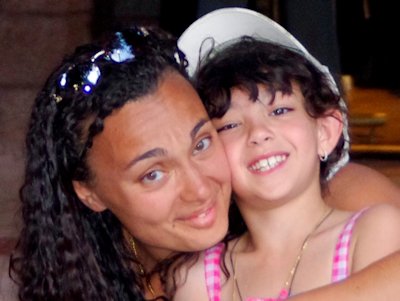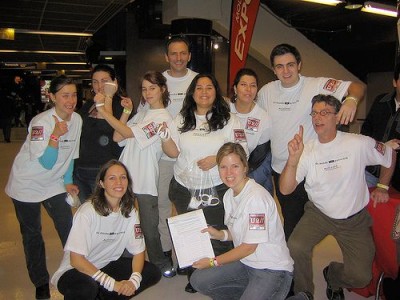
When it comes to youth leadership, Eden Eskaros is learning about social innovation at a young age.
On a recent trip to Mexico, Eden, age 10, was horrified to learn that children lived in dismal situations, using cardboard boxes as beds. She also noticed they had no shoes. Eden was moved to help these children by making a commitment to bring back 100 pairs of shoes on her next trip.
She returned home to New Jersey and enlisted the aid of a local shoe store and her church. As a result, she’s prepared to send over 1,000 pairs of shoes to her new friends in Mexico.
Eden’s story is a great example of how children are often transformed by face-to-face interactions with people living in poverty. Clearly, Eden has developed the ability to empathize, to put herself in the place of another. Most children develop this capacity by the age of six and are capable of taking action to help people in need. They particularly benefit from seeing the direct benefits of their actions.
Close to the age where she will ask deeper questions about poverty, Eden Eskaros is on her way to becoming an engaged, compassionate citizen. During adolescence, children’s brains develop the capacity to understand the systemic issues involved in helping those in need. For example, Eden may begin to ask, “Why are children living in poverty?” or, “What are the root causes of poverty?”
In Tomorrow’s Change Makers: Reclaiming the Power of Citizenship for a New Generation, I studied youth leadership — how young people adopt passionate causes, most often between the ages of 14 and 18. Developmentally, this is the age when kids form civic identities that often stay with them for the rest of their lives.
Raising children to become active citizens doesn’t happen by chance. The students in my study reflected on their childhoods and adolescence and the critical experiences that led them to work for civic causes. Being familiar with the common steps in their journeys can help parents, educators, and other adults support kids through these important learning experiences. And it can help develop effective youth leadership programs.
Engaging Youth: Leadership Development in Five Steps
1. Connecting to Others in Need
Kids who develop a passion to serve can usually point to a critical experience that became transformative for them. Like Eden Eskaros, the experience frequently involves face-to-face interaction with people who are different from them, and most often, with people who are in need. These youth leadership experiences might occur in food banks, homeless shelters, nursing homes, disaster areas, and places where people live in poverty. Similarly, those who work for environmental causes point to intense moments of learning, involving a deep personal connection to nature or animals. Their youth leadership experiences might occur in animal shelters, wildlife refuges, or experiential projects that raise awareness of environmental issues. These experiences can occur at young ages, long before children have the intellectual ability to understand the complexities of the situation.
2. Confronting Moral Dilemmas
During adolescence, teenagers develop the capacity to think in more complex, interconnected ways. The potential for youth leadership occurs when teenagers form relationships with people in need. This creates moral dilemmas for them. They begin to ask questions that compare their own circumstances to others. For the first time, they may wonder why people are hungry or why children are homeless. The same is true for the environment. Kids feel such a connection to nature that they begin to ask deep moral questions about how we care for the planet like, “Why don’t we pay attention to climate change?” or, “Why don’t we protect certain species of animals?”
3. Reflecting on Values
As they consider these moral dilemmas, adolescents reach deep within and think about their values. Instead of mimicking the opinions they have heard from others, such as parents or friends, they begin to form their own conclusions. They need to process their feelings with adults who are not judgmental, who trust in their abilities to find their own answers. Often, these adults are leaders of volunteer programs, older siblings, or a favorite teacher. Encouraging teens to discuss their feelings with others, or even write about them, helps facilitate learning.
4. Shifting Perspectives
Through reflection, talking with others, and linking their values to the issues that impact them, young people experience a shift in perspective. They begin to see how issues are connected to each other, and they become interested in understanding the root causes of societal problems. For example, they may see links between social and environmental issues, understanding that climate change will most affect people living in poverty. They may connect sex trafficking with girls living in poverty in Cambodia. They may understand the need for breast cancer research because it affected a mother or aunt. This is a turning point for youth leadership — a time that begins to fuel an inner purpose and passion toward specific, important causes.
5. Creating a Passionate Civic Identity
Young people reach the last step in this journey when they see themselves as active, engaged citizens. They are able to articulate their beliefs about how they understand a social or environmental issue and they hold a worldview that incorporates themselves as agents of change. They know that small things they do to contribute to social and environmental causes have a big impact. At this point, they are ready and able to make a long-term commitment to serving the public good. They have a passion for giving!
Adult Support: An Essential Ingredient
Eden Eskaros could not have achieved her goal at age 10 without the help of her parents and other supportive adults. Likewise, teenagers also speak passionately about the adults who played a supportive role in their route to adopting passionate causes. These adults help young people believe in themselves.
Students reported six main ways adults helped. They 1) supported and encouraged, 2) listened, 3) set high expectations, 4) showed interest in them as individuals separate from academics or civic activities, 5) fostered self-decision making, and 6) provided another perspective during problem-solving.
Understanding the common ways kids navigate the challenges of volunteering may help adults mentor children and adolescents more effectively.
Youth Civic Engagement and Civics Education Resources
CIRCLE: The Center for Information & Research on Civic Learning and Engagement, Tufts University College of Citizenship and Public Service
Engaged Youth: Civic Learning Online, University of Washington
John W. Gardner Center for Youth and Their Communities, Stanford University
Youth Service America, Washington DC
Published: August 9, 2011
Tags: empathy, initiative, moral development, parenting, service-learning, youth civic engagement



